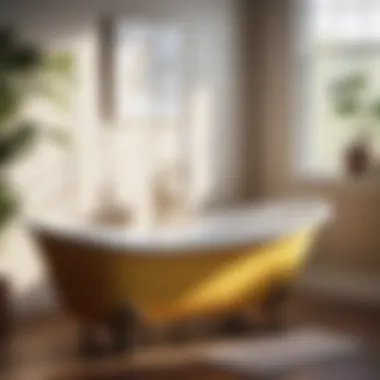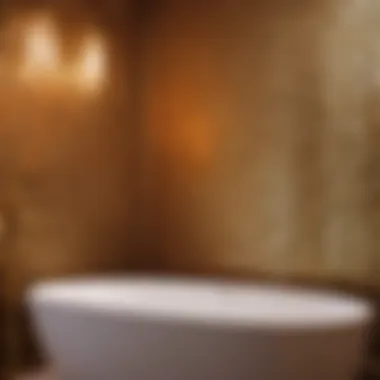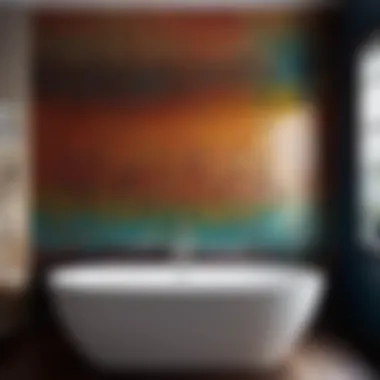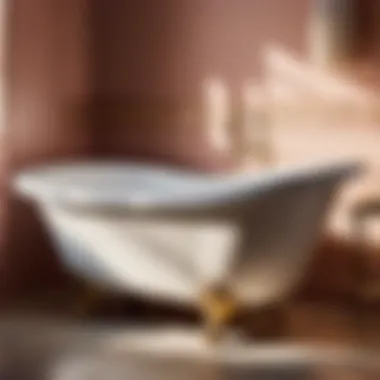Transform Your Bathroom: Expert Guide to Tub Painting Techniques


Materials:
- Tub and Tile Refinishing Kit (exact measurement: 1 kit)
- Protective gloves (exact measurement: 1 pair)
- Sandpaper (exact measurement: 1 sheet of each grade – coarse, medium, fine)
- Paint roller (exact measurement: 1)
- Paintbrush (exact measurement: 1)
- Primer (exact measurement: 1 quart)
- Tub cleaner (exact measurement: 1 bottle)
- Masking tape (exact measurement: 1 roll)
DIY Steps:
- Clean the tub thoroughly using the tub cleaner and rinse it well. Allow it to dry completely.
- Use the sandpaper to roughen the surface of the tub. Start with the coarse grit, then move to medium, and finish with a fine grit for a smooth finish.
- Apply the primer evenly to the entire surface of the tub using the paint roller. Let it dry according to the manufacturer's instructions.
- Stir the tub and tile refinishing kit thoroughly. Apply the first coat with the paint roller, then use the paintbrush for corners and edges. Allow it to dry completely before applying the second coat.
- Once the final coat is dry, remove the masking tape carefully to reveal clean lines.
Technical Aspects:
- Tools: Ensure you have the necessary tools like gloves, sandpaper, roller, brush, etc., for a smooth painting process.
- Timing: Allocate sufficient time for each step, especially drying times between coats, to avoid any disruptions to the finish.
- Techniques: Follow the manufacturer's instructions for the refinishing kit for the best results. Pay attention to application techniques for a professional finish.
DIY Project Process:
- Preparation is key: Clean and sand the tub properly for optimal adhesion of the primer and paint.
- Application: Apply each coat meticulously, ensuring even coverage for a seamless finish.
- Drying and curing: Allow each coat to dry fully before moving on to the next step. Avoid using the tub until the paint has cured completely.
Troubleshooting Tips:
- If you encounter drips or uneven coverage, lightly sand the affected area and reapply the paint for a seamless finish.
- In case of bubbles or imperfections, lightly sand the surface and apply a fresh coat to rectify the issue.
Introduction
Painting a bathroom tub can significantly transform the look and feel of your bathroom, giving it a fresh and updated appearance. This guide will take you through the comprehensive process involved in revamping your bathroom by painting the tub. From understanding the benefits to considering factors before painting, gathering necessary tools, the preparation stage, actual painting process, and post-painting care, each step is essential in achieving a professional finish.
Understanding the Benefits of Painting a Bathroom Tub
Enhancing the Aesthetics of Your Bathroom
Enhancing the aesthetics of your bathroom through tub painting offers a cost-effective way to revamp a key focal point in the space. By updating the color and finish of your tub, you can instantly elevate the overall look of your bathroom. This choice is beneficial as it adds a fresh and modern touch without the hefty price tag of replacing the entire tub. However, it is essential to note that while painting can provide a quick aesthetic upgrade, it may require periodic touch-ups to maintain its appearance over time.
Cost-Effective Alternative to Replacement
Opting to paint your bathroom tub instead of replacing it presents a cost-effective alternative that can save you money while still achieving a brand-new look. This approach is popular among homeowners looking to renovate on a budget without compromising on style. One of the key advantages of this method is the significant savings it offers compared to the higher costs associated with tub replacement. However, it's essential to consider the condition of the existing tub and seek professional advice if there are structural concerns that paint alone cannot address.
Customizing Your Bathroom Design
Customizing your bathroom design through tub painting allows you to personalize the space according to your preferred color scheme and style. Whether you desire a pop of color, a sleek monochromatic finish, or a textured effect, painting your tub provides versatility in design options. This customization feature is valuable as it gives you the freedom to tailor your bathroom to your taste and current decor trends. Nonetheless, it's crucial to carefully select colors and finishes that harmonize with the existing elements in your bathroom for a cohesive and visually appealing result.
Factors to Consider Before Painting
Type of Tub Material
Understanding the type of material your tub is made of is crucial before embarking on the painting process. Different tub materials, such as porcelain, fiberglass, or acrylic, require specific paint types and preparation methods to ensure adhesion and durability. Each material has its own characteristics, with some being more receptive to paint than others. It is essential to research and identify the material of your tub to select the appropriate paint products and techniques that will result in a long-lasting and professional finish.
Existing Surface Condition


The existing surface condition of your tub plays a significant role in determining the success of the painting project. Any cracks, chips, or damage on the surface must be addressed before painting to ensure a smooth and even application. Proper cleaning and preparation of the tub surface are essential to promote paint adhesion and prevent peeling or flaking over time. Evaluating the current state of the tub and addressing any surface imperfections will contribute to a successful and visually pleasing outcome.
Color and Finish Selection
Choosing the right color and finish for your painted tub is a critical decision that will impact the overall aesthetics of your bathroom. The color scheme should complement the existing decor and contribute to the desired ambiance of the space. Whether opting for a bold statement color or a classic white finish, the chosen hue should align with your design vision and personal style. Additionally, selecting a durable finish that is resistant to water and daily wear will ensure longevity and maintain the freshly painted look of your tub.
Gathering the Necessary Tools and Materials
Sandpaper and Degreaser
Sandpaper and degreaser are essential tools for preparing the tub surface before painting. Sandpaper helps roughen the surface to promote paint adhesion, while degreaser removes any residue or oils that can hinder proper bonding. The key characteristic of sandpaper is its abrasive quality, allowing for efficient smoothing of the tub surface. Similarly, degreaser is favored for its ability to thoroughly clean and degrease the surface, ensuring a pristine base for paint application.
Paintbrushes and Rollers
Paintbrushes and rollers are indispensable for applying the paint smoothly and evenly onto the tub surface. The key characteristic of paintbrushes lies in their precision and versatility, allowing for detailed work on edges and corners. Rollers, on the other hand, are ideal for covering larger areas quickly and efficiently. Choosing high-quality brushes and rollers is essential for achieving professional results and ensuring uniform coverage of the painted surface.
Epoxy or Acrylic Tub Paint
Selecting the appropriate type of paint for your tub is crucial in achieving a durable and long-lasting finish. Epoxy or acrylic tub paint is specifically formulated to withstand moisture, chemicals, and frequent cleaning in bathroom environments. The key characteristic of these paints is their waterproof and resilient properties, making them ideal for high-moisture areas like bathrooms. While epoxy paint provides a thicker and more protective finish, acrylic paint offers a smoother and more affordable option. Consider the specific requirements of your tub material and usage patterns to choose the most suitable paint for your project.
Preparation Stage
In the process of revamping your bathroom by painting the tub, the Preparation Stage plays a crucial role in ensuring a successful outcome. This stage sets the foundation for the entire painting process, dictating the quality and longevity of the finish. By meticulously preparing the tub surface, you pave the way for a professional-looking result that enhances the aesthetics of your bathroom.
Proper preparation involves cleaning and sanding the tub surface, masking off surrounding areas to protect walls and fixtures, as well as applying primer and base coat. These steps are vital for promoting paint adhesion, creating an even surface, and achieving a durable finish that withstands the test of time.
Cleaning and Sanding the Tub Surface
Removing Existing Grime and Residue
When it comes to removing existing grime and residue from the tub surface, attention to detail is key. By thoroughly cleaning the tub surface, you eliminate any dirt, soap scum, or deposits that can affect the adhesion of the paint. Using a suitable degreaser and sandpaper, ensure that the surface is smooth and free from any contaminants that could diminish the paint's durability.
Ensuring proper adhesion of the paint is essential for the paint to bond effectively with the tub surface, preventing peeling or chipping over time. By removing grime and residue, you create a clean canvas for the paint to adhere to, promoting a seamless finish that lasts.
Ensuring Proper Adhesion of the Paint
To achieve optimal results when painting a bathroom tub, ensuring proper adhesion of the paint is paramount. By following the necessary steps to prepare the surface, such as cleaning, sanding, and choosing the right products, you enhance the paint's grip on the tub surface.
Proper adhesion minimizes the risk of paint flaking or peeling prematurely, preserving the quality of the finish. This crucial step not only improves the visual appeal of the painted tub but also contributes to the overall longevity and durability of the painted surface.
Masking Off Surrounding Areas
Protecting Walls and Fixtures from Overspray
When painting a tub, protecting walls and fixtures from overspray is essential to prevent unintended paint marks and stains. By masking off surrounding areas with painter's tape and plastic sheeting, you safeguard walls, tiles, and other bathroom elements from paint splatter.


Securing clean lines for a professional finish is achieved by ensuring precise masking, leaving only the tub surface exposed for painting. This meticulous approach results in a clean and polished look that resembles a professional job.
Securing Clean Lines for a Professional Finish
A crucial aspect of achieving a professional finish when painting a bathroom tub is securing clean lines. By meticulously applying painter's tape along the edges of the tub and surrounding areas, you create defined boundaries that prevent paint from encroaching onto unwanted surfaces.
Maintaining clean lines throughout the painting process ensures a neat and uniform finish that elevates the overall appearance of the tub. This attention to detail is instrumental in achieving a high-quality outcome that transforms the look of your bathroom.
Applying Primer and Base Coat
Promoting Paint Adhesion
When preparing to paint a bathroom tub, applying primer plays a vital role in promoting paint adhesion. Primer acts as a bonding agent between the tub surface and the paint, enhancing adhesion and ensuring long-lasting color retention.
Creating an even surface with a base coat before applying the final coat of paint is crucial for achieving a smooth and flawless finish. The base coat fills imperfections, seals the surface, and provides a uniform canvas for the topcoat, enhancing the durability and longevity of the painted tub.
Creating an Even Surface
Achieving an even surface on the tub is essential for a seamless and professional-looking finish. By applying a base coat after priming the surface, you ensure that the paint adheres uniformly, resulting in consistent color distribution and coverage.
Creating an even surface not only enhances the aesthetic appeal of the painted tub but also contributes to its durability. An even surface minimizes the risk of imperfections and inconsistencies, providing a flawless appearance that revitalizes your bathroom's design.
Painting Process
In the realm of revamping your bathroom, the painting process stands as a pivotal stage, dictating the success and overall aesthetic of your renewed tub. Employing the right techniques and approaches during this phase can elevate the outcome to a professional standard, seamlessly blending functionality with style. Through a meticulous execution of each step within the painting process, you have the opportunity to breathe new life into your bathroom space and create a visually appealing focal point that reflects your personal taste and design vision.
Techniques for Painting the Tub
Brush Application vs. Rolling
Delving into the comparison between brush application and rolling techniques for painting your tub unveils a critical decision-making aspect in this renovation journey. While brush application offers precision and detail work, rolling provides a more uniform and efficient coverage. Choosing between these methods depends on the desired finish and personal preference. Opting for brush application brings forth intricacy, ideal for intricate designs or patterns. On the other hand, rolling covers larger surface areas quickly, ensuring a consistent coat across the entire tub. Each technique carries its own advantages and considerations, catering to different needs and design aspirations within the context of this article.
Ensuring Even Coverage
Achieving uniform coverage during the painting process is essential to guarantee a seamless, aesthetically pleasing final result. Ensuring even coverage involves meticulous attention to detail, avoiding patchy or uneven areas that could compromise the overall look of the tub. By maintaining a consistent application technique and monitoring paint distribution, you can achieve a smooth and professional finish that revitalizes the tub's appearance. This aspect of painting underscores the importance of patience and precision in creating a flawless surface that enhances the overall ambiance of the bathroom.
Avoiding Drips and Runs
One of the challenges during the painting process is the occurrence of drips and runs, which can mar the finish of the tub and create inconsistencies in the color and texture. Preventing drips and runs requires a steady hand and controlled application of the paint, ensuring that each coat adheres smoothly without excess pooling. By mastering techniques such as correct brush handling and managing paint consistency, you can circumvent these issues and achieve a flawless result. The meticulous approach to avoiding drips and runs complements the meticulous nature of the entire painting process, emphasizing the importance of attention to detail for a successful transformation.
Multiple Coats and Drying Time
Achieving Desired Color Depth
The journey toward achieving the ideal color depth for your painted tub involves strategic application of multiple coats to enhance the richness and vibrancy of the chosen hue. Layering the paint systematically allows for the gradual buildup of color, ensuring a saturated and long-lasting finish. By considering the existing tub material and surface condition, you can tailor the number of coats to achieve the desired color depth that complements your bathroom's overall aesthetic. This aspect of the painting process amplifies the transformative power of color, ushering in a renewed ambiance and visual appeal to your bathing space.


Allowing Sufficient Drying Time
Patience becomes a virtue when it comes to allowing the sufficient drying time between coats, a crucial element in the longevity and durability of your painted tub. Rushing this process can lead to premature wear and compromised adhesion, diminishing the quality of the finish. By adhering to recommended drying times and environmental conditions, you safeguard the integrity of your paint job, ensuring a lasting and resilient surface that withstands daily use. This emphasis on proper drying time upholds the meticulous nature of the painting process, highlighting the dedication required for a successful bathroom revamp.
Finishing Touches and Cleanup
Removing Painter's Tape
A seemingly minor yet significant step in the painting process, removing painter's tape marks the transition from application to revealing the crisp edges and defined borders of your painted tub. This act of precision and care ensures a clean, professional finish that accentuates the newly painted surface. By delicately peeling off the tape, you unveil the meticulous craftsmanship that went into transforming your bathroom fixture, showcasing attention to detail and a commitment to quality.
Cleaning Brushes and Rollers
Post-painting cleanup involves the meticulous care of brushes and rollers used in the application process, preserving their longevity and functionality for future projects. Thoroughly cleaning these tools removes residual paint and maintains their performance, readying them for the next renovation endeavor. Incorporating proper brush and roller maintenance into your post-painting routine upholds the standard of excellence set during the painting process, indicating a comprehensive approach to home improvement and aesthetics.
Inspecting for Imperfections
A final inspection for imperfections offers the opportunity to refine and perfect the painted tub surface, addressing any inconsistencies or flaws that detract from the overall finish. By scrutinizing the entire area for drips, bubbles, or uneven areas, you can rectify these issues through touch-ups or refinishing techniques. This meticulous examination highlights the dedication to quality and precision exhibited throughout the painting process, ensuring a flawless and professional outcome that elevates your bathroom's visual allure.
Post-Painting Care
After the exhilarating task of painting your bathroom tub, it is essential to shift your focus towards post-painting care to ensure the longevity and maintenance of your newly transformed tub. Post-painting care plays a crucial role in preserving the aesthetic and functionality of the tub, ultimately maximizing your investment in time and effort. This section delves into the meticulous procedures and considerations involved in caring for your painted tub.
Curing and Maintenance Tips
Allowing Sufficient Cure Time
Allowing sufficient cure time is a paramount aspect of post-painting care that cannot be understated. It involves granting ample time for the paint to fully cure and harden, ensuring its durability against wear and tear. Adequate curing time allows the paint to adhere correctly to the surface, preventing premature chipping or deterioration. In this context, choosing the optimal cure time is vital, as rush curing can compromise the finish quality and longevity of the paint.
Cleaning and Maintaining the Painted Surface
Maintaining the cleanliness of the painted surface is another critical element of post-painting care. Regular cleaning helps to preserve the visual appeal of the tub and prevent the buildup of grime or contaminants that can impair the paint finish. Using mild cleaners and gentle scrubbing tools is recommended to avoid damaging the painted surface. Establishing a routine cleaning schedule will not only enhance the longevity of the paint but also contribute to a fresh and vibrant appearance of your bathroom tub.
Troubleshooting Common Issues
Bubbles or Blisters in the Paint
The occurrence of bubbles or blisters in the painted surface can be a common issue post-painting, stemming from improper application techniques or environmental factors. These imperfections not only detract from the aesthetic appeal but also compromise the integrity of the paint layer. Understanding the root causes of bubbles or blisters is crucial in implementing effective solutions to rectify them and restore the seamless finish of the tub.
Uneven Color Distribution
Uneven color distribution in the paint finish can detract from the overall visual impact of the tub, creating a patchy or irregular appearance. This issue may arise due to inconsistent application methods, incomplete coverage, or variations in paint thickness. Addressing uneven color distribution requires meticulous attention to detail, ensuring uniformity in color intensity and coverage across the entire surface of the tub.
Long-Term Durability and Considerations
Factors Affecting Paint Longevity
Several factors influence the longevity of the paint on your bathroom tub, including the quality of materials used, environmental conditions, and the frequency of use. Understanding these factors equips you with the knowledge to prolong the vibrancy and durability of the paint, preserving the seamless finish for an extended period. By proactively addressing these longevity factors, you can enhance the lifespan of the painted surface and maintain its aesthetic appeal over time.
Refreshing the Paint as Needed
As part of long-term maintenance, refreshing the paint periodically may be necessary to revitalize the appearance of the tub and address any signs of wear or fading. This process involves inspecting the painted surface for any flaws or imperfections and applying touch-up coats as required. Refreshing the paint not only ensures the continuous visual allure of the tub but also serves as a proactive measure to prevent extensive damage or deterioration.







